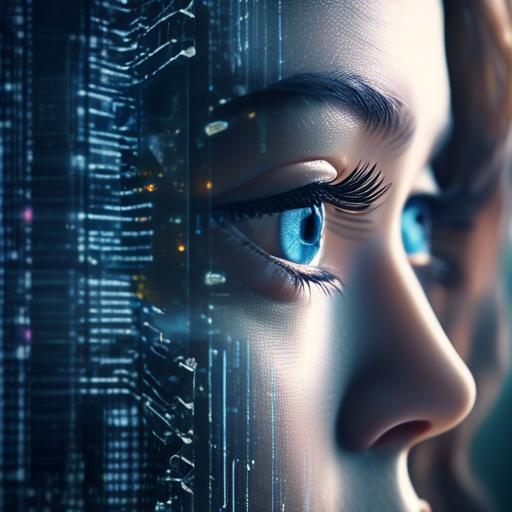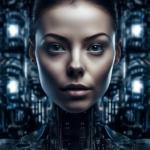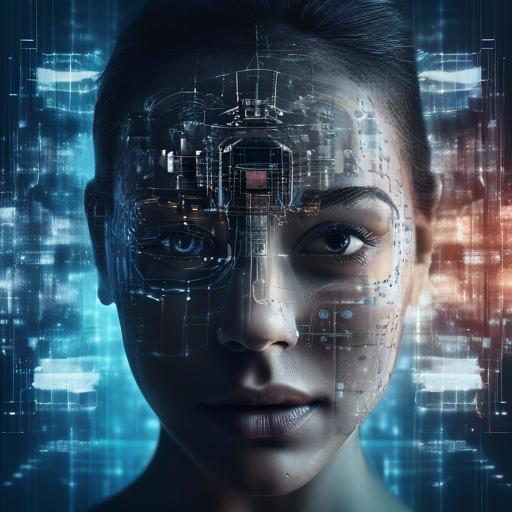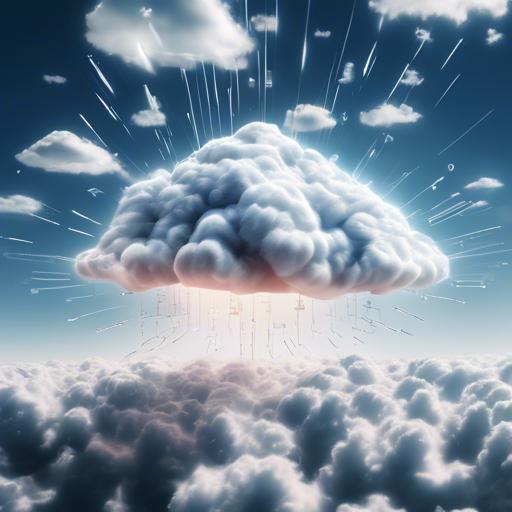In a world where the flicker of screens and the shutter of cameras punctuate our lives, the marvel of artificial intelligence has unwrapped a new layer of creativity — AI image generation. Imagine a universe where you can conjure breathtaking landscapes or fashion portraits with the mere stroke of a digital brush. Yet, beneath this facade of artistic liberation, a complex tapestry woven with threads of privacy concerns begins to unfold.
Welcome, dear reader, to a journey through the digital labyrinth where innovation and personal boundaries intersect. Let’s embark on this exploration together, uncovering the hidden facets of our imaginations while safeguarding the sanctity of our personal space. As we delve into the enchanting, and at times unsettling, world of AI-generated imagery, let’s pledge to illuminate the shadows and inspire a future where creativity and privacy coexist harmoniously.
Table of Contents
- Ethical Implications of AI-Generated Imagery
- Understanding User Consent in Image Creation
- The Risks of Facial Recognition and Data Misuse
- Balancing Creativity and Confidentiality in AI Art
- Ensuring Anonymity in Digital Portrait Generation
- Protecting Personal Data in Collaborative AI Projects
- Best Practices for Mitigating Privacy Threats
- To Wrap It Up
Ethical Implications of AI-Generated Imagery
The advancement of AI technology has ushered in an age where the creation of hyper-realistic images is not only possible but increasingly common. This powerful capability, while innovative, brings forth a raft of ethical considerations, primarily centered on privacy. AI-generated imagery, often indistinguishable from real photographs, can easily be manipulated or misused, raising questions about the boundaries of personal privacy in the digital era.
One of the primary concerns is **misrepresentation and identity theft**. AI can generate images of individuals who do not exist or modify the appearances of real individuals in ways that can deceive observers. This can be particularly problematic in contexts such as fake news, social media manipulation, and online fraud. For example, an AI-generated photo of a person could be used to create fake social media profiles, leading to a loss of trust and potential harm to individuals mistakenly involved.
Another pressing issue relates to **consent and control**. People are increasingly sharing images online, but AI’s capacity to synthesize new images raises significant concerns about consent. Imagine a scenario where an individual’s photos are used without their permission to create completely new, realistic images—this is not just a violation of privacy, but potentially a breach of trust and personal control over one’s likeness.
| AI Image Generation Risks | Potential Impacts |
|---|---|
| Identity Theft | Misleading representation, fraud |
| Non-Consensual Use | Violation of privacy, trust issues |
| Deepfake Creation | Damage to reputations, misinformation |
**Deepfakes** represent another ethical dilemma. These AI-generated videos and images can place individuals in compromising or harmful situations digitally, which can then be disseminated widely, causing significant reputational damage. Celebrities, politicians, and even everyday individuals can be targeted, leading to serious emotional and professional repercussions. The line between what is real and what is fabricated becomes increasingly blurred, challenging the adequacy of current laws and protections.
while AI-generated imagery holds vast potential for creativity and innovation, the privacy implications cannot be ignored. Ethical frameworks and robust legal measures are ESSENTIAL to ensure that this technology is used responsibly. Empowering users with greater control over their digital identities and establishing clearer guidelines can help mitigate potential harms, fostering a more secure and respectful digital environment.
Understanding User Consent in Image Creation
In the ever-evolving landscape of AI image generation, **user consent** plays a critical role. It’s not just a matter of privacy but a fundamental aspect of trust and ethical considerations. Whether it’s artists, photographers, or everyday users, obtaining explicit consent ensures that the use of personal or proprietary images is fair and respectful.
Key areas where user consent is pivotal:
- Data sourcing: Understanding where the images are coming from and ensuring they’re sourced legally.
- Representation: Ensuring individuals are comfortable with how their likeness is used in AI-generated content.
- Distribution: Defining clear boundaries regarding where and how these images can be shared.
In many cases, platforms that generate images using AI provide settings where users can control the use of their data. Tools might include **opt-ins/opt-outs**, **permissions settings**, and **detailed consent forms** to ensure transparency. Here’s an example:
| Consent Type | Description |
|---|---|
| Opt-In | Users actively agree to have their images used by the AI platform. |
| Opt-Out | Users’ images are used by default unless they specifically decline. |
| Granular Permissions | Users specify particular use cases where their images can or cannot be utilized. |
Beyond legal and ethical obligations, prioritizing user consent fosters a more supportive and engaged community. When users feel they have control over their contributions, they are more likely to engage positively with the platform and its services.
By embedding consent as a cornerstone of your AI image generation processes, you not only adhere to global compliance standards but also build a trust-driven environment where creativity thrives responsibly.
The Risks of Facial Recognition and Data Misuse
Facial recognition software is often hailed for its accuracy and efficiency; however, with its rise comes an alarming potential for data misuse. **Private companies and government agencies** alike deploy this technology, sometimes without thoroughly considering the ramifications on individuals’ privacy. One of the most immediate risks involves unauthorized surveillance. Facial recognition could effectively transform a public space into a monitored zone where every movement is scrutinized.
Moreover, **data breaches** pose a significant threat. Once facial data is stored, it becomes a target for cyberattacks. Hackers could potentially gain access to this sensitive information, creating a multitude of problems, including identity theft and unauthorized tracking. Unlike a password, you can’t change your face, making the damage permanent and far-reaching. This calls into question the security measures that organizations must take to protect such irreplaceable data.
As if unauthorized surveillance and data breaches aren’t alarming enough, there’s also **the concern of bias in facial recognition systems**. Many of these technologies have been found to have higher error rates for people of color, women, and the elderly. This could lead to cases of mistaken identity, wrongful arrests, and other severe consequences, further marginalizing already vulnerable communities.
- Unauthorized Surveillance
- Data Breaches
- Bias and Misidentification
Due to these concerns, it’s essential to have robust regulations and clear ethical guidelines when implementing facial recognition systems. **Transparency from developers** and operators about how the technology works and how the data is used can go a long way in building public trust. Furthermore, informed consent should be a non-negotiable aspect of any deployment.
| Risk | Impact | Mitigation |
|---|---|---|
| Unauthorized Surveillance | Invasion of Privacy | Strict Regulation |
| Data Breaches | Identity Theft | Enhanced Security Protocols |
| Bias and Misidentification | Marginalization | Algorithm Audits |
Balancing Creativity and Confidentiality in AI Art
In the quest to generate awe-inspiring art through artificial intelligence, creators often walk a tightrope between innovation and privacy. The potential of AI to aggregate vast amounts of data for the purpose of creating something entirely new is fascinating, but it raises critical concerns about how that data is used and protected.
**Key considerations include:**
– **Source of Data:** Was the data collected ethically and with proper consent?
– **Data Security:** Is the data being securely stored and transmitted?
– **Privacy Risks:** What are the potential privacy implications for individual data used in AI art creation?
**Balancing creativity and confidentiality comes down to adhering to best practices:**
– **Anonymization:** Critical data should be anonymized to protect individuals’ identities.
– **Data Minimization:** Collect only the data that’s absolutely necessary for the project.
– **Consent and Transparency:** Clearly inform contributors about how their data will be used and ensure they provide consent.
| Best Practices | Benefits |
|---|---|
| Anonymization | Protects individual privacy |
| Data Minimization | Reduces risk exposure |
| Consent and Transparency | Builds trust with contributors |
It’s essential for artists and developers to champion robust **data governance policies**. Doing so not only encourages **creativity** but also instills **confidence** in users whose data fuels these artistic innovations. Ensuring transparent practices increases the likelihood of user collaboration and positive reception of AI-generated artwork.
By following these guidelines, creators can harness the full potential of AI in art without compromising on the ethical principles that underpin responsible data usage. Balancing these priorities allows the fusion of technology and artistry to flourish while maintaining the utmost respect for individual privacy.
Ensuring Anonymity in Digital Portrait Generation
In the evolving landscape of AI-driven creativity, digital portrait generation has gained significant attention for its potential. However, it also raises valid concerns about user anonymity. Ensuring anonymity in this domain means employing techniques that both safeguard personal identity and grant users peace of mind.
Key Strategies for Protecting Anonymity:
- **Data Minimization**: Only necessary data should be utilized. Reducing the amount of personal information limits the potential for identity exposure.
- **Obfuscation**: Techniques such as blurring, pixelation, or abstract representation can anonymize identifiable features in generated portraits.
- **Secure Data Storage**: Ensuring that data, even anonymized, is stored securely using encryption and other cybersecurity measures is paramount.
- **User Consent**: Obtaining explicit consent before using any data ensures that users are aware and agree to the extent of data use.
Comparison of Anonymity Techniques
| Anonymity Technique | Pros | Cons |
|---|---|---|
| Data Minimization | Reduces data misuse risk | Limits model precision |
| Obfuscation | Preserves privacy visually | May affect portrait quality |
| Secure Data Storage | Protects data integrity | Requires robust infrastructure |
| User Consent | Empowers user control | Potentially slows down processes |
Deploying a combination of these strategies can create a robust framework for protecting user identity in AI image generation. Balancing anonymity with technological capability requires both creative and technical finesse, making it an ongoing challenge worth the effort for both developers and users.
Protecting Personal Data in Collaborative AI Projects
The rapid advancement of AI-powered image generation introduces an array of privacy concerns, particularly in collaborative projects. It’s crucial for teams to establish protocols that safeguard personal data while fostering innovation. By taking a proactive approach, stakeholders can ensure that data privacy remains a priority without stifling creativity.
One effective strategy is to implement **robust access controls**. Clearly defined roles and permissions help minimize the risk of unauthorized access. For example, only key team members should have access to sensitive data sets, reducing potential leakage points. Additionally, it’s essential to regularly audit access logs to swiftly identify and address any suspicious activity.
| Role | Access Level |
|---|---|
| Project Manager | Full Access |
| Data Scientist | Data Analysis |
| Developer | Code Repository |
| External Reviewer | Read Only |
Beyond access control, embracing **data anonymization techniques** can further protect privacy. This involves altering datasets so that individual identities are obscured but the usefulness of data remains intact. Techniques such as masking, pseudonymization, and differential privacy can be employed to ensure that even if data is compromised, personal information remains protected.
Another key component is fostering a culture of **awareness and training** among team members. Regular workshops and updates on best practices for data protection can empower everyone involved to take an active role in maintaining privacy standards. Hands-on training sessions can also simulate common threats, helping the team to respond adeptly in real-time scenarios.
In addition to these measures, utilizing **privacy-preserving AI frameworks** can provide an extra layer of security. These frameworks, such as federated learning, allow AI models to be trained on decentralized data without it ever leaving its source. This significant innovation not only enhances privacy but also reduces the risk of data breaches during collaborative endeavors.
Best Practices for Mitigating Privacy Threats
Ensuring the privacy of individuals when using AI for image generation requires a multi-faceted approach. One of the primary methods is implementing **data anonymization techniques**. Removing personally identifiable information (PII) from training datasets can greatly reduce the risks associated with data breaches.
Next, consider utilizing **differential privacy**. By injecting small amounts of statistical noise into the datasets, it becomes exceedingly difficult to trace the data back to any individual. This technique preserves the utility of the dataset while significantly enhancing privacy.
An essential practice involves **restrictive data access**. Ensure that only authorized personnel have access to sensitive data. Implement robust authentication mechanisms, and conduct regular audits to verify compliance. Additionally, encrypt data both at rest and in transit to prevent unauthorized access.
- Conduct regular privacy impact assessments to identify and mitigate potential privacy threats before they materialize.
- Implement robust consent mechanisms to ensure that data subjects are fully aware of how their data will be used and have given explicit permission.
- Update privacy policies frequently to address the evolving landscape of AI technology.
| Best Practices | Description |
|---|---|
| Data Anonymization | Remove PII to reduce breach risks. |
| Differential Privacy | Inject statistical noise to protect individual data. |
| Restrictive Data Access | Limit access to sensitive data through robust authentication. |
To Wrap It Up
As we navigate the evolving landscape of AI image generation, it is essential to prioritize the protection of privacy rights. By understanding the potential risks and taking proactive steps to address them, we can ensure that this technology is used responsibly and ethically. Let’s continue to advocate for transparent practices, robust security measures, and thoughtful regulations to safeguard our privacy in the digital age. Together, we can harness the power of AI for the greater good while respecting the rights and dignity of individuals. Stay informed, stay vigilant, and let’s shape a future where innovation and privacy can coexist harmoniously.
































